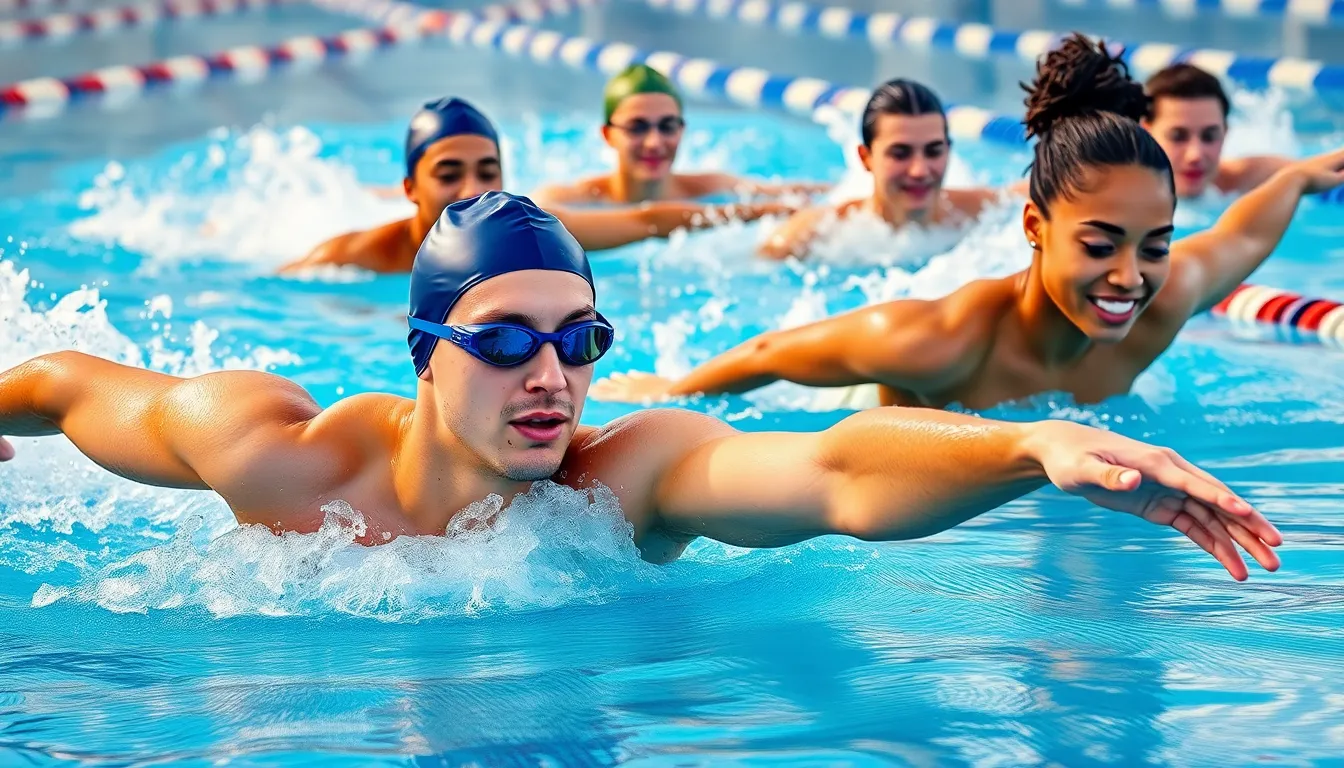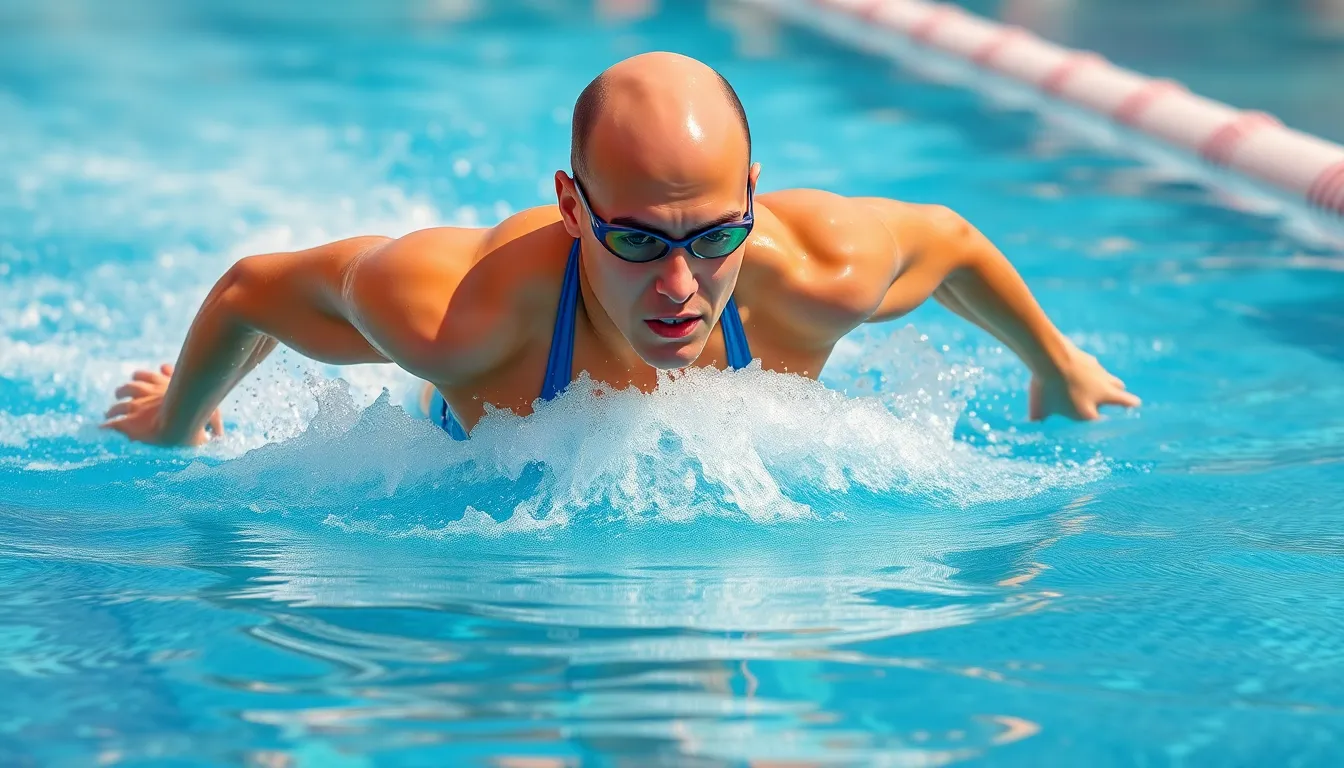Table of Contents
ToggleSwimming workouts offer a fantastic way to build strength and improve cardiovascular fitness while enjoying the refreshing embrace of water. Whether you’re a seasoned swimmer or just starting out, incorporating effective swimming routines can elevate your training and keep things exciting.
With a variety of strokes and drills to choose from, swimmers can target different muscle groups and enhance their endurance. Not only does swimming provide a full-body workout, but it also minimizes the risk of injury, making it suitable for all fitness levels. Dive into the world of swimming workouts and discover how to maximize your time in the pool for optimal results.
Benefits Of Swimming Workouts
Swimming workouts provide numerous advantages, including a comprehensive approach to fitness that enhances overall well-being. Below are some key benefits explained further.
Full-Body Workout
Swimming engages multiple muscle groups simultaneously, promoting balanced strength and flexibility. Each stroke—freestyle, backstroke, breaststroke, and butterfly—targets different muscles, ensuring a full-body workout. Stroke variations improve coordination and stability while increasing cardiovascular endurance. Regular practice develops mobility and strength throughout the core, arms, and legs, making swimming an effective exercise for targeted muscle development.
Low-Impact Exercise
Swimming represents a low-impact alternative to other forms of exercise, reducing stress on joints. The buoyancy of water supports the body, making swimming ideal for individuals with injuries, arthritis, or chronic pain. This low resistance allows for greater joint movement without the risk of injury. Because it minimizes strain, swimming promotes long-term fitness sustainability and encourages people of all ages and fitness levels to stay active.
Types Of Swimming Workouts

Swimming workouts can vary significantly based on goals and preferences. Below are several types of workouts designed to enhance different aspects of swimming performance.
Endurance Training
Endurance training improves stamina and promotes cardiovascular efficiency. Swimmers often engage in longer sessions, typically ranging from 1,500 to 3,000 meters. Common sets include continuous swimming or extended distance swims at a moderate pace. Swimmers may utilize different strokes to target various muscle groups while maintaining a steady effort to enhance aerobic capacity.
Interval Training
Interval training focuses on sprinting and rest periods to build speed and strength. Swimmers alternate between high-intensity efforts and shorter recovery times. Typical sets may include 50- to 200-meter sprints, followed by rest intervals of 10 to 30 seconds. This type of training boosts anaerobic capacity and improves overall race performance by increasing the ability to recover quickly between bursts of speed.
Technique Focused Workouts
Technique-focused workouts emphasize stroke mechanics and efficiency. These sessions may include drills that isolate specific aspects of swimming, such as body position, breathing, and kick technique. Exercises can range from using pull buoys and kickboards to practicing stroke patterns at a slower pace. Swimmers spend time perfecting their form, which leads to improved speed and reduced energy expenditure during competition.
Essential Gear For Swimming Workouts
Proper gear enhances swimming workouts and contributes to overall performance and comfort. The right equipment minimizes distractions and maximizes efficiency in the water.
Swimwear
Swimwear plays a vital role in swimming workouts. Swimmers should choose suits that fit snugly and reduce drag. Common materials include polyester and spandex for durability and flexibility.
- Training Suits: Designed specifically for swim training, these suits offer a balance of comfort and performance.
- Racing Suits: These suits, often made from advanced fabrics, minimize drag, promoting speed during competitions.
- Board Shorts: Ideal for water aerobics or casual swimming, these provide extra coverage and comfort but may increase resistance.
Selecting the right swimwear helps swimmers maintain focus on their technique and workout goals.
Goggles and Accessories
Goggles enhance visibility underwater and protect eyes from chlorine and saltwater. Swimmers must ensure a comfortable fit to prevent leaks and discomfort.
- Training Goggles: These typically feature adjustable straps and anti-fog lenses for extended use during workouts.
- Racing Goggles: Designed for a streamlined fit, these goggles offer minimal drag and wider lenses for better visibility.
- Swim Caps: Swim caps keep hair out of the face and reduce drag, contributing to speed and comfort during workouts.
Additional accessories like earplugs, nose clips, and waterproof watches can improve the training experience by enhancing focus and tracking performance.
Tips For Effective Swimming Workouts
Effective swimming workouts require clear strategies and consistent practices to achieve optimal results. Focusing on goal-setting and consistency can significantly enhance performance and progression in the water.
Setting Goals
Setting specific, measurable goals empowers swimmers to track their progress and stay motivated. Establish short-term objectives, such as improving lap times or increasing stroke count, alongside long-term aspirations like completing a distance event. Consider the following goal types:
- Performance Goals: Aim to enhance stroke technique, reduce drag, or increase speed in specific strokes.
- Endurance Goals: Target longer swim distances over time, gradually increasing yardage each week.
- Skill Development Goals: Focus on mastering new techniques, such as turns, starts, or breathing patterns.
By regularly evaluating and adjusting goals, swimmers can maintain focus and adapt their training as needed.
Maintaining Consistency
Consistency plays a crucial role in achieving successful swimming workouts. Regular practice not only builds endurance but also reinforces muscle memory. Implement these strategies for maintaining workout consistency:
- Create a Schedule: Establish a weekly routine with designated swim days and times. Stick to the plan to build daily habits.
- Track Progress: Keep a swim log to record workouts, distances, and improvements. Reviewing this record can provide motivation.
- Join a Group: Swim with peers or teams to enhance motivation through friendly competition and shared accountability.
By committing to a consistent routine, swimmers can optimize their performance and ensure continuous progress in their aquatic fitness journey.
Swimming workouts offer a unique blend of strength building and cardiovascular conditioning. They cater to all fitness levels and provide a low-impact alternative to traditional exercises. By incorporating various strokes and drills swimmers can enhance their endurance and technique while minimizing injury risks.
With the right gear and a structured approach to training swimmers can maximize their time in the pool. Setting specific goals and maintaining consistency are key to achieving optimal results. Embracing these practices will not only improve performance but also foster a lifelong commitment to fitness through swimming.




